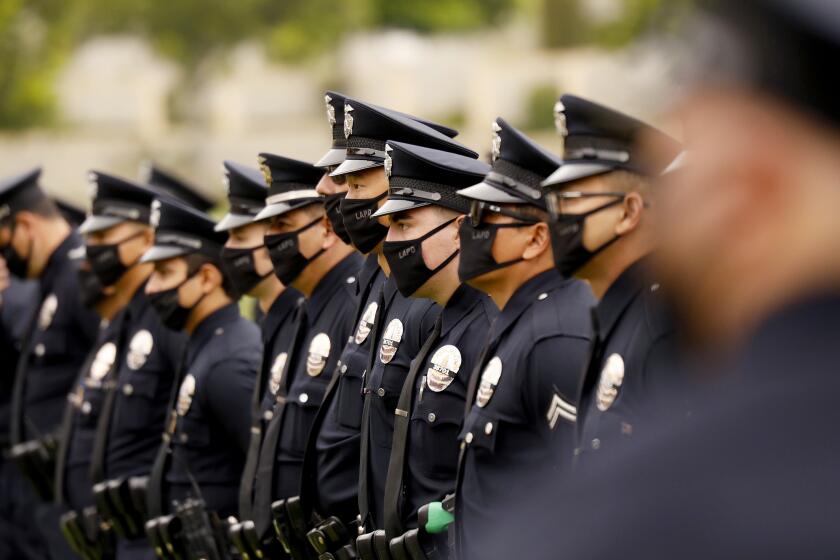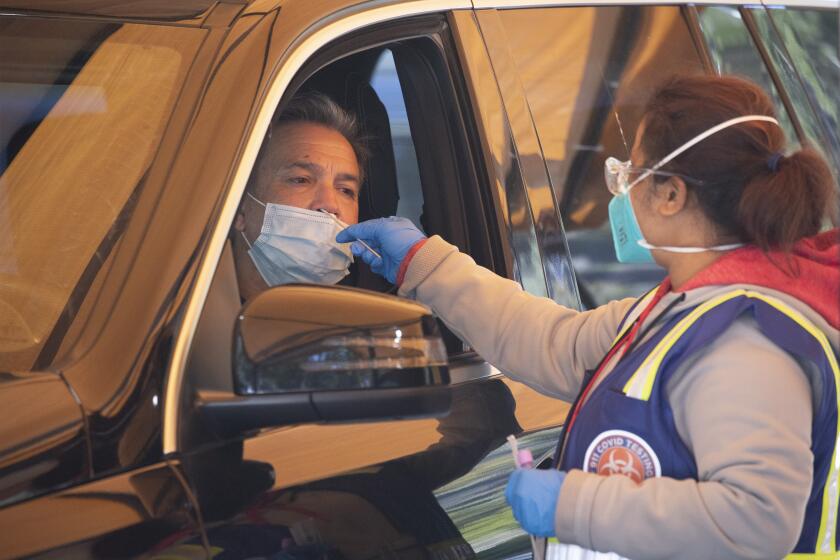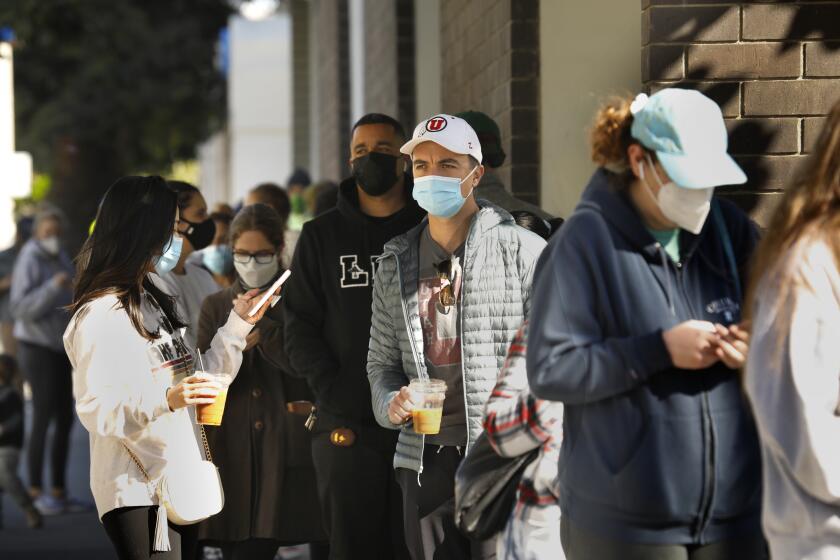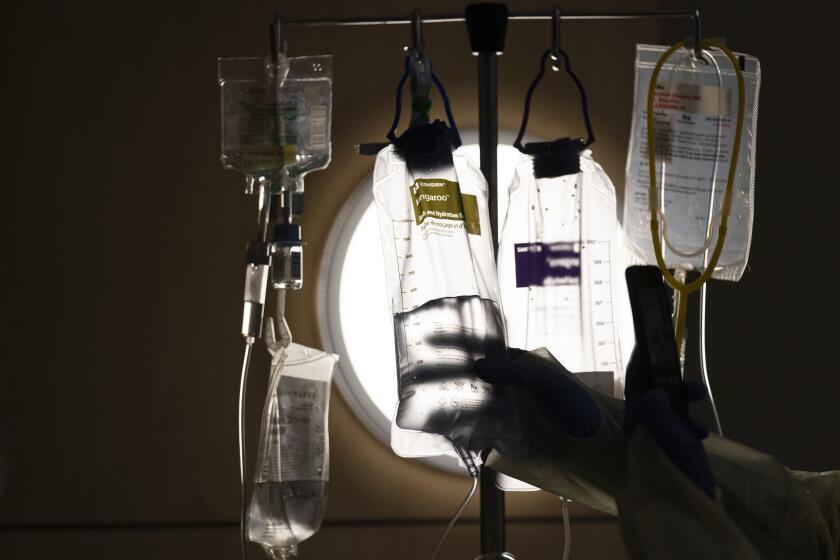California extends indoor mask mandate as Omicron surges
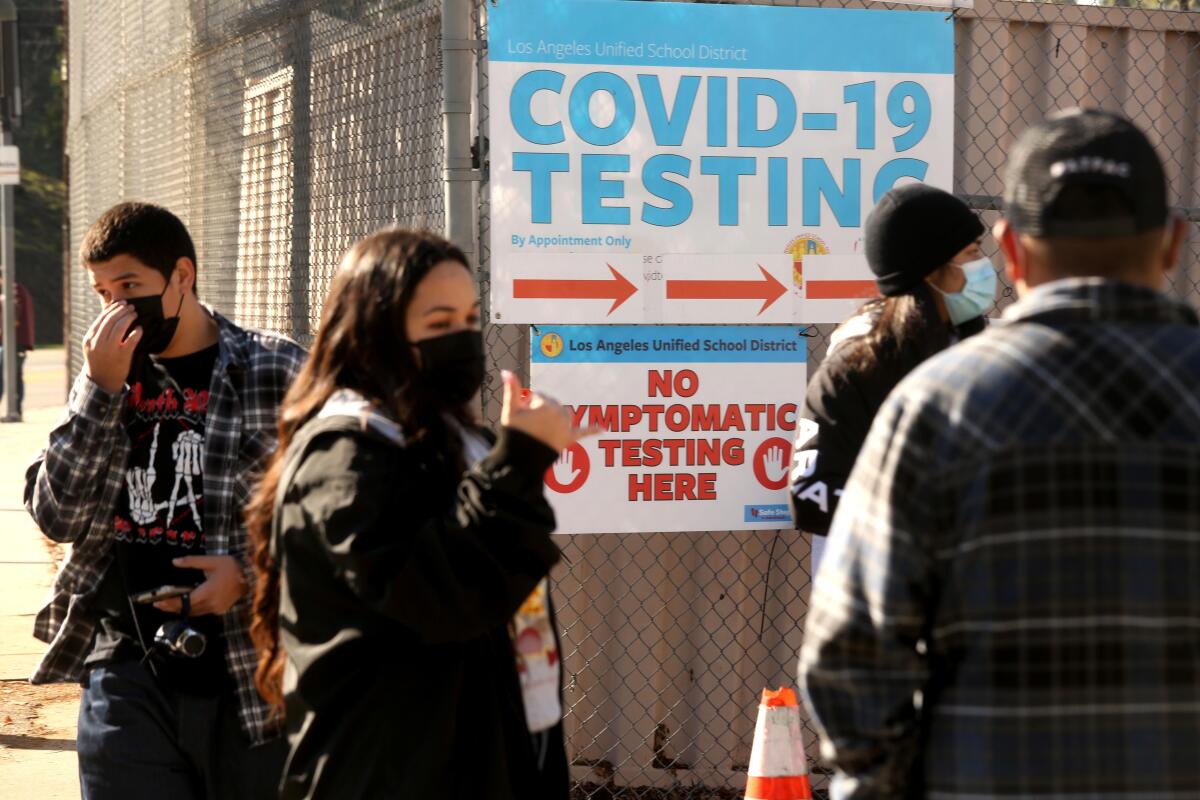
California will extend its mask mandate for indoor public spaces for another month as an unprecedented wave of coronavirus infections spawned by the highly transmissible Omicron variant continues to wash over the state.
The crush of cases is also sparking fresh concerns about the state’s hospitals, which are contending with both a flood of new patients and rising infections among their sorely needed staff.
While COVID-19 hospitalizations are a fraction of what they were last year, overall hospitalizations for all reasons are quite high. Many hospitals across Southern California report being strained, in part because few employees are available due to coronavirus infections, and because demand for non-COVID care is much higher this winter.
In both L.A. and Orange counties, it’s taking longer to offload patients from ambulances into hospitals; in L.A. County, 911 response times have worsened. Across the region, some hospitals have been forced to place on hold or reschedule some surgeries. The staffing shortage is considered by some in San Diego County as worse than during last winter’s surge.
Since Omicron can spread so readily, officials say wearing masks adds a much-needed layer of protection. But the quality of the mask also matters, and officials have been warning that old, loose fitting cloth masks alone with gaps around the mouth are too risky to use in the Omicron era.
On Wednesday, Los Angeles County officials announced that employers will be required to provide well-fitting medical grade masks, surgical masks or respirators — such as N95s or KN95s — to employees who work indoors in close contact with others.
Employers are required to do so as soon as possible, but no later than Jan. 17, officials said.
“Given the explosive spread of the virus, activities that put us in close contact with many other people now have an increased risk,” said county Public Health Director Barbara Ferrer. “As such, everyone needs to be sensible about how to protect themselves and those they love by layering on protections whenever around non-household members.”
The statewide mask order was reinstituted in mid-December and was originally set to be reevaluated Jan. 15. But given the sharp rise in infections and hospitalizations, it will be in place through at least Feb. 15, said Dr. Mark Ghaly, California’s health and human services secretary.
The mandate applies to residents regardless of their vaccination status. Exemptions are in place for those younger than 2, who have certain medical conditions or are hearing-impaired, and people “for whom wearing a mask would create a risk to the person related to their work, as determined by local, state or federal regulators or workplace safety guidelines.”
A number of California counties — including Los Angeles, Ventura, Sacramento and most of the San Francisco Bay Area — have their own indoor mask mandates on the books that, unlike the state’s, have no specified end dates. The statewide order applied to counties that didn’t already have local indoor mask mandates in place, such as San Diego, Orange, Riverside and San Bernardino counties.
During a briefing call with reporters, Ghaly expressed both caution about the pandemic’s recent trends and confidence in the state’s ability to tackle the new wave.
“Our level of preparedness and the tools we have in our toolbox are much more significant than we had before,” he said Wednesday.
California has reported an average of 54,695 new coronavirus cases per day over the last week, the highest rolling total in the nearly two-year pandemic, according to data compiled by The Times. During last winter’s surge, California peaked at about 46,000 new cases a day.
That metric may be warped by data delays over the New Year’s holiday weekend and the subsequent batch of several days’ worth of numbers reported Tuesday. But the trendline has been near-vertical lately, illustrating how suddenly and starkly transmission has surged statewide.
More than 1,000 police officers, firefighters and paramedics in the Los Angeles region were ill or at home quarantining on Tuesday after testing positive for COVID-19.
The share of coronavirus tests coming back positive also has rocketed to record levels — reaching a seven-day rate of 21.3% as of Wednesday, according to the California Department of Public Health.
Despite the worsening metrics, Ghaly said California is not considering reimposing the sort of economic restrictions enacted at the start of the pandemic. Tools such as masking, testing and vaccines, he said, still provide ample protection.
“We are not discussing business closures or further limitations on businesses or other sectors of our economy and for the schools,” Ghaly said.
“We also know that the level of immunity that we’ve created primarily due to vaccines has allowed us to sort of treat Omicron as, frankly, a little less virulent, a little less likely to cause severe disease, because we have high levels of immunity from so many Californians getting vaccinated, and those who’ve gotten prior infection,” Ghaly said. “We can manage the disease burden that we’re seeing in a way that we weren’t able to a year ago.”
A ‘flurona’ case was detected at a testing site in Brentwood in a teenager who had just returned from a family vacation in Mexico.
While some of the recent cases are likely the work of the still-circulating Delta variant, officials across the state and nation have said it appears Omicron has rapidly outmuscled the other once-dominant variant.
The Centers for Disease Control and Prevention now estimates that Omicron represents about 95% of cases nationwide, with Delta accounting for the rest.
“The coming weeks are going to be challenging. We’re going to see cases continue to rise because Omicron is a very transmissible variant,” said Jeff Zients, the White House coronavirus response coordinator.
So far, though, the number of people being hospitalized with COVID-19 has not risen at the same staggering rate as cases.
California has reported a massive backlog of 237,084 new coronavirus cases, pushing the seven-day average of new infections to 50,267, a record high.
While hospitalizations tend to lag about two weeks behind increases in infections, the recent disconnect may be the result of Omicron causing less-severe symptoms, on average, than the Delta variant.
That’s not to say California’s healthcare systems have been completely insulated from the case spike.
On Tuesday, 8,032 such patients were hospitalized statewide. That total has swelled 69% in the last week, and is now threatening to top the highest patient count recorded during last summer’s surge: 8,353 on Aug. 31.
Some counties — including Los Angeles, San Bernardino, San Diego, Riverside, Orange, Santa Clara and Ventura — have already reported coronavirus-positive patient counts higher than those during the Delta wave.
Statewide, hospitalizations still remain well below the levels seen last winter, when nearly 22,000 coronavirus-positive individuals were being cared for on some days.
With Omicron spreading with unprecedented speed across California, public and private institutions return to remote work and close some offices.
However, Ghaly pointed out that hospitals are caring for far more than just those stricken with COVID-19. The overall demand is much higher.
Around this time last year, roughly 53,000 people were hospitalized statewide — afflicted with everything from COVID-19 to heart disease to injuries. As of Wednesday morning, the state’s total patient count was approaching 51,000.
“We are worried about the total hospital census. We are worried with the level of staff infections and the need for isolation and quarantine among the staff,” Ghaly said.
Officials also note that a proportion of those who have tested positive for the virus at a hospital may not have been admitted specifically for COVID-19. However, the extent of such incidental infections remains unclear.
In Orange County, at least nine hospitals have already set up surge tents to increase capacity, Dr. Regina Chinsio-Kwong, a deputy health officer, said Wednesday. She urged people not to come to emergency rooms just to get a coronavirus test.
“Our hospitals are getting full; our ERs are getting full,” Chinsio-Kwong said. “So if you are looking for a test, and you have mild symptoms, please consider first a virtual appointment with your healthcare provider to not overwhelm the ERs even more.”
One trend that has become worrisome is pediatric hospitalizations. “More young people with COVID are being admitted” into hospitals, Ghaly said. “In California, we have admitted more [of these] patients on a day-to-day basis over the last few days than we did even at the peak of last winter’s surge, and, as a pediatrician, anytime a young child is admitted to the hospital, there is concern.”
The good news, however, is that children’s hospitals across the state still have the capacity to treat the number of COVID-patients needing that level of care. And many of those children are not needing intensive care, or needing a breathing tube, Ghaly said.
Increases in transmission carry repercussions that go beyond the raw patient count.
Some healthcare systems and hospitals have reported rising numbers of employees getting infected with the coronavirus, exacerbating staffing challenges.
“We’ve been at this now for two years, and healthcare workers are fatigued, exhausted,” said Adam Blackstone, vice president of external affairs and strategic communications for the Hospital Assn. of Southern California.
Hospital workers and other healthcare employees have been getting infected with the coronavirus in rising numbers as cases skyrocket in Los Angeles County, compounding staff shortages at medical centers.
While growing indications of Omicron’s lessened severity are a promising development, “the big caveat is we should not be complacent, since the increased transmissibility of Omicron might be overridden by the sheer volume of the number of cases,” said Dr. Anthony Fauci, President Biden’s chief medical advisor.
“A certain proportion of a large volume of cases, no matter what, are going to be severe,” he said during a briefing Wednesday. “So don’t take this as a signal that we can pull back from the recommendations.”
Those can be broadly broken down into four steps, according to CDC Director Dr. Rochelle Walensky: “Get vaccinated and get boosted if you are eligible. Wear a mask. Stay home when you’re sick, and take a test if you have symptoms or are looking for greater extra reassurance before you gather with others.”
Late Wednesday, the CDC recommended that vaccinated adolescents as young as age 12 get a booster shot.
“We now recommend that all adolescents aged 12-17 years should receive a booster shot five months after their primary series. This booster dose will provide optimized protection against COVID-19 and the Omicron variant,” Walensky said.
Times staff writers Emily Alpert Reyes and Gregory Yee and Paul Sisson of the San Diego Union-Tribune contributed to this report.
More to Read
Sign up for Essential California
The most important California stories and recommendations in your inbox every morning.
You may occasionally receive promotional content from the Los Angeles Times.
